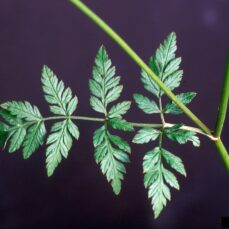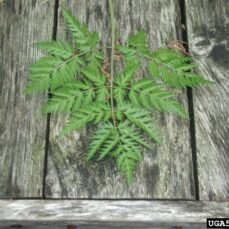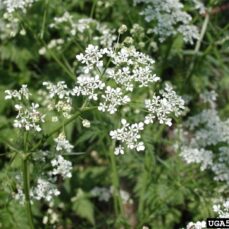
Photo credit: Leslie J. Mehrhoff, University of Connecticut, Bugwood.org
Management Category
Squamish
Whistler
Pemberton
Vectors of Spread
ID Characteristics
General: Wild chervil is a biennial or short-lived perennial from the carrot family (Apiacaeae). It forms rosettes in the first year of growth, and flowers in the second to fourth year.
Flowers: Small white flowers form umbrella-like clusters (umbels) that produce two joined seeds with tiny antenna-like structures at their tips.
Stem: Hollow, ridged, hair-covered stems. These carrot family plants are tall, upright, and can grow 0.3 – 1.8 m tall.
Leaves: Triangular, dividing leaves that appear fern-like and softly hairy. Foliage has a slightly sweet, musty odor.
Seeds: The seeds are narrow and 6 – 7mm long. At immaturity the seeds are green and turn to a shiny brown as they mature.
Roots: Parental taproots with thick, tuberous extensions that can extend over 2 m deep. Wild Chervil has taproots that spread aggressively.
Similar Species
Native

Pacific water-parsley (Oenanthe sarmentosa) is extremely similar to wild chervil, but it tends to creep in shallow water.
Caution: Pacific water-parsley is poisonous. DO NOT TOUCH.
Invasive

Photo credit: D. Hare
Poison hemlock (Conium maculatum) is from the same family as wild chervil, and as such they share many characteristics. The main difference between the two is their height: Poison hemlock is much taller, as it often reaches 2 – 3 m or more at maturity. Another distinctive feature of poison hemlock is the purple-red splotching or streaking on its stems.
CAUTION: All parts of the poison hemlock plant are poisonous, including the flowers, leaves, stems, roots, and seeds. It contains potent toxic alkaloids that affect the nervous system, and even small internal doses can cause respiratory collapse and death.
It can also cause a severe skin reaction similar to a burn when touched.
Non-native

Sweet cicely (Myrrhis odorata) has fern-like foliage similar to wild chervil, and loves shade. Contrary to poison hemlock, it does not post any threats to human or animal health; in fact, all parts of the plant are edible!
Other members of the carrot family (Apiaceae) may also be confused for wild chervil. You can learn more about the identification and management of carrot family plants here.
Additionally, you can refer to the Fraser Valley Invasive Species Society’s guide to help you tell wild chervil apart from other plants of the same family.
Habitat and Origin
Wild chervil is native to Europe. It grows in moist to wet disturbed areas at low to mid-elevations, such as ditches, stream banks, moist woods, riparian areas, roadsides, fence lines, and pastures. Wild chervil can tolerate part-shade but prefers open sites.
Wild chervil is widespread throughout the Fraser Valley, and rare sightings have been reported in Squamish.
How it Spreads
Wild chervil is spread both by vegetatively and by seed. Its root buds are generally responsible for the local expansion of existing plant populations; moreover, wild chervil is a prolific seed producer.
Wild chervil can spread through the mowing of roadsides and ditches, as well as through transport by birds, waterways (ditches), and contaminated wildflower seed mixes.
Impacts
Health:
- Contact with wild chervil sap may cause burns when the skin is exposed to sunlight.
Ecological:
- Can act as a host for certain viruses that affect vegetable clops, particularly plants of the same family (e.g., carrots, parsnips, celery), like yellow fleck virus.
- May shade out smaller plants.
- Outcompetes native plants, reducing biodiversity.
- Particularly damaging to riparian areas.
Economic:
- Out-competes pasture and hay crops, reducing forage for grazing animals.
- Livestock avoid it due to its unpalatable taste.
Prevent the Spread
Wild chervil is NOT currently found in the Sea to Sky Region, so PREVENTION is key:
- Regularly monitor properties for weed infestations.
- Remove plant material from equipment, vehicles or clothing used in infested areas and wash equipment and vehicles at designated cleaning sites before leaving infested areas.
- Ensure soil and gravel are uncontaminated before transport.
- Minimize soil disturbances (e.g., use grazing plants that prevent soil exposure from overgrazing), and use seed mixes with dense, early colonization (e.g., alfalfa or barley) to re-vegetate exposed soil and resist invasion.
- Ensure invasive plants (particularly flowering heads or root fragments) are bagged or covered to prevent spread during transport to designated disposal sites (e.g., landfill). Do NOT compost.
Control
Mechanical control:
- Hand-pull young plants before seed production begin; if plants are mature, the plants must be dug from below the root crown; plants must be cut, bagged, and deeply buried at the landfill; do NOT compost.
- Remove the entire taproot to prevent re-sprouting.
- Smothering (by covering an area to block the plant’s access to air and sunlight) and infestation with PVC lining may also kill plants.
- Minimize soil disturbances, as this will promote germination of seeds banked in the soil. Cutting and mowing will minimize seed spread, but will also cause the plant to flower several times in a season and develop an extensive taproot.
Caution: It is recommended to wear gloves when handling wild chervil, as it may cause skin irritation.
Chemical control:
- Treatment with a selective herbicide with some residual activity or with a non-selective herbicide has proven effective. However, the wet habitat it often resides in makes herbicide application difficult or impossible.
- Aminopyralid and metsulfuron-methyl; aminocyclophyrachlor and chrosulfuron; dicamba; imazapyr; glyphosate; metsulfuron; aminopyryralid; 2-4 D; and dicamba have been proven effective in certain conditions.
- We recommend that any herbicide application is carried out by a person holding a valid BC Pesticide Applicator Certificate. Before selecting and applying herbicides, you must review and follow herbicide labels and application rates; municipal, regional, provincial and federal laws and regulations; species-specific treatment recommendations, and site-specific goals and objectives.
Biological control:
- No known biological agents exist for wild chervil.
Sea to Sky Distribution
Wild Chervil Factsheet
Having trouble viewing the factsheet? Don’t worry, all the information is included on this page. You can also contact us with any questions.
Additional Resources
References
- E-Flora BC, Athriscus sylvestris
- Fraser Valley Invasive Species Society, Look-alike Guides
- Invasive Plant Atlas of the United States, Wild Chervil
- Invasive Species Council of BC, Wild Chervil
- Invasive Species Council of BC, Wild Chervil TIPS Factsheet
- Metro Vancouver, Best Management Practices for Wild Chervil in the Metro Vancouver Region
- Ontario’s Invading Species Awareness Program, Wild Chervil
- Washington State Noxious Weed Control Board, Wild Chervil
- Whatcom County Noxious Weed Control Board, Control Options for Wild Chervil

















